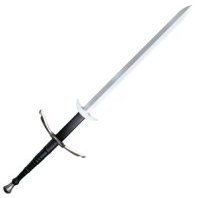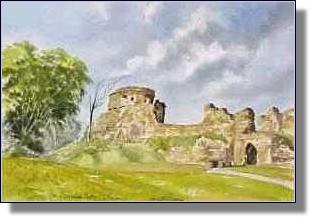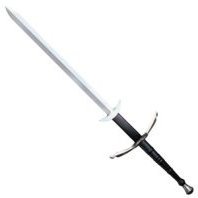"It is a
revered thing
to see an ancient
castle not in decay,
but how much more it is
to behold an ancient family
which has stood against the waves
and weathers of time."
 --- Francis Bacon
--- Francis Bacon


 y name is
Anthony McGuinness
(
Antóin MacAonghusa in the Irish language...
) and I live in the charming little early 19th century village of Ardglasson, in county Meath, around 30 miles from the east coast of
Ireland.
My family is descended from a warrior named
Conall Cearnach
, leader of the Knights of the Red Branch, who were the elite guard of
Conor Mac Nessa
, king of Ulster in the 1st century A.D., whose palace stood at
Eamhain Macha
, two miles west of the present city of Armagh, in what is now "Northern" Ireland.
y name is
Anthony McGuinness
(
Antóin MacAonghusa in the Irish language...
) and I live in the charming little early 19th century village of Ardglasson, in county Meath, around 30 miles from the east coast of
Ireland.
My family is descended from a warrior named
Conall Cearnach
, leader of the Knights of the Red Branch, who were the elite guard of
Conor Mac Nessa
, king of Ulster in the 1st century A.D., whose palace stood at
Eamhain Macha
, two miles west of the present city of Armagh, in what is now "Northern" Ireland.
 Under king Conor MacNessa, the fabled Knights of the Red Branch, renowned throughout Ireland for their
ethical code and respect for honour, reached the climax of their fame.They were led by Cúchulainn, Ireland's immortal and most famous hero. His semi-legendary, semi-historical story is principally told in the greatest of Irish epics, the "Táin Bó Cuailgne", or Cattle Raid of Cooley. In an epic four-day struggle characterized by the unbelievable chivalry of both contestants, who had been friends since childhood, Cúchulainn saved Ulster in a battle against the rest of Ireland, by reluctantly slaying the great and noble Ferdia, leader of Connaught's Knights of the Sword.
Under king Conor MacNessa, the fabled Knights of the Red Branch, renowned throughout Ireland for their
ethical code and respect for honour, reached the climax of their fame.They were led by Cúchulainn, Ireland's immortal and most famous hero. His semi-legendary, semi-historical story is principally told in the greatest of Irish epics, the "Táin Bó Cuailgne", or Cattle Raid of Cooley. In an epic four-day struggle characterized by the unbelievable chivalry of both contestants, who had been friends since childhood, Cúchulainn saved Ulster in a battle against the rest of Ireland, by reluctantly slaying the great and noble Ferdia, leader of Connaught's Knights of the Sword.

 I'm
naturally
reserved when it comes to personal description and such,
but if you really want to
know a little more about me, then have a word with old "Charles",
the Celtic scribe,
over
there to your right.
If you tap him gently on the shoulder, he may lead
you to the information you require. I'm sure he won't
object to your disturbing
his literary endeavours for a moment or two...
I am very proud of my Irish
ancestry,
which is why this page has a distinctly historical theme, and I hope that
within the many rooms and corridors of my virtual castle you may
discover some of the enchanting qualities
of the land of my ancestors...
I'm
naturally
reserved when it comes to personal description and such,
but if you really want to
know a little more about me, then have a word with old "Charles",
the Celtic scribe,
over
there to your right.
If you tap him gently on the shoulder, he may lead
you to the information you require. I'm sure he won't
object to your disturbing
his literary endeavours for a moment or two...
I am very proud of my Irish
ancestry,
which is why this page has a distinctly historical theme, and I hope that
within the many rooms and corridors of my virtual castle you may
discover some of the enchanting qualities
of the land of my ancestors...


 f you look at the Magennis
crest
, or coat-of arms, you will see a red hand at the top, a symbol long
associated with the Magennisses, and carried into battle by them down through
the
centuries. Also depicted is the golden lion of king Milesius of Spain, whose
race vanquished the legendary Tuatha Dé Danaan, the people of the goddess Danú,
who were allowed to hold the kingdom of the "Otherworld", and who afterwards
became the "Daoine Sídhe", or fairies, of Irish folklore, due to their reputed magical
powers.
Conall Cearnach was himself descended from Heber Donn, a grandson of
Milesius, who took part in the colonisation of "Inisfáil", or the Isle of
Destiny, as it was known to them. The Ireland of today takes its name from Ir
MacMile, the king's son.
f you look at the Magennis
crest
, or coat-of arms, you will see a red hand at the top, a symbol long
associated with the Magennisses, and carried into battle by them down through
the
centuries. Also depicted is the golden lion of king Milesius of Spain, whose
race vanquished the legendary Tuatha Dé Danaan, the people of the goddess Danú,
who were allowed to hold the kingdom of the "Otherworld", and who afterwards
became the "Daoine Sídhe", or fairies, of Irish folklore, due to their reputed magical
powers.
Conall Cearnach was himself descended from Heber Donn, a grandson of
Milesius, who took part in the colonisation of "Inisfáil", or the Isle of
Destiny, as it was known to them. The Ireland of today takes its name from Ir
MacMile, the king's son.


 he territory of the Magennises originally covered most of the area of the
Mourne Mountains
,
in what is now Northern Ireland.
In 1994,
I had the privilege of visiting many of the sites associated with
my ancestors, including the Magennis
Coronation Stone
, or
"Coisleach Aonghuis"
at Warrenpoint, in County Down. We also visited the
original "Magennis Castle"...Dundrum Castle, already referred to above. Another
site associated with my family is
Narrow Water Castle, on the shores of Carlingford Lough, which has an interesting but
tragic tale associated with it concerning Lassara,
one of the ladies of the Magennis Clan, who met an untimely end there before
her father, Conn Magennis and the rest of the Clan
avenged her death. The full and very poignant story of her misfortune is
related in
"The Death Of Lassara"
he territory of the Magennises originally covered most of the area of the
Mourne Mountains
,
in what is now Northern Ireland.
In 1994,
I had the privilege of visiting many of the sites associated with
my ancestors, including the Magennis
Coronation Stone
, or
"Coisleach Aonghuis"
at Warrenpoint, in County Down. We also visited the
original "Magennis Castle"...Dundrum Castle, already referred to above. Another
site associated with my family is
Narrow Water Castle, on the shores of Carlingford Lough, which has an interesting but
tragic tale associated with it concerning Lassara,
one of the ladies of the Magennis Clan, who met an untimely end there before
her father, Conn Magennis and the rest of the Clan
avenged her death. The full and very poignant story of her misfortune is
related in
"The Death Of Lassara"


 reland is a
very ancient place; a land steeped in mythology, folklore, and the eerie
mists of legend, and for
those with eyes to see beyond the materialism and pragmatism of the present day, much magic remains in its
historic
landscape. Beneath the veneer of the modern, vibrant country lies an
infinitely older and mystical Ireland, with its sagas and heroes, its triumphs
and
tragedies, beckoning to
us down the dusty corridors of time...The countryside of Ireland
still retains many of the structures and fortifications which bear witness to
the chequered history of this mystical place; The ceremonial sites and burial places of the
earliest
inhabitants, considered as entrances to the "Otherworld" by the Celts, whose arrival they preceded by thousands of years;
the ruined castles and tower houses built by the Anglo-Norman invaders of the 12th century; the
elegant 18th-century mansions of the Georgian aristocracy... All have their stories to tell.
reland is a
very ancient place; a land steeped in mythology, folklore, and the eerie
mists of legend, and for
those with eyes to see beyond the materialism and pragmatism of the present day, much magic remains in its
historic
landscape. Beneath the veneer of the modern, vibrant country lies an
infinitely older and mystical Ireland, with its sagas and heroes, its triumphs
and
tragedies, beckoning to
us down the dusty corridors of time...The countryside of Ireland
still retains many of the structures and fortifications which bear witness to
the chequered history of this mystical place; The ceremonial sites and burial places of the
earliest
inhabitants, considered as entrances to the "Otherworld" by the Celts, whose arrival they preceded by thousands of years;
the ruined castles and tower houses built by the Anglo-Norman invaders of the 12th century; the
elegant 18th-century mansions of the Georgian aristocracy... All have their stories to tell.

 n the face of slaughter, starvation, plague and subjugation, why have the Irish
for so long held to a belief in faith and ancient magic? Why have they so stubbornly held to their superstitious beliefs in spirits and the "little people", and in the magical sanctity
of their sacred land? In the pain of long suffering and adversity, what else was there to hold onto other than the bedrock of their age-old traditions and folklore?
It is out of this suffering and great hardship that some of the world's greatest saints, patriots, poets and writers have arisen to inspire us, like the phoenix rising out of the ashes of its own destruction to be reborn again.
Out of the ashes of invasion, starvation and pestilence, the Irish fought and sacrificed their men and women to retain their ancient island, and to achieve its independence once again. Out of those same ashes, Ireland and her
people have risen to bring the magic of her legends, her music and her dance to
a world hungry for renewed spirituality, inspiration and a diversion from the gray drabness of materialism and cultural uniformity. Perhaps the true magic of Ireland lies not beneath the hills and mounds of
this emerald land, in the memories of its ancient pagan festivals, the illumination of its Christian gospels, or even the great stone megaliths which dot its countryside...Ireland's true magic lies in the very hearts
of her own indigenous people; A people who have never bowed to savage injustice, pain and hardship, and who fought long and hard for everything they held dear, even as they still fight now for freedom from terror and
intolerance in their sacred homeland. This tenacity is a tribute to ourselves and our ancestors, and to the timeless endurance of our Celtic and earlier foundations. This is the magic of Ireland...
n the face of slaughter, starvation, plague and subjugation, why have the Irish
for so long held to a belief in faith and ancient magic? Why have they so stubbornly held to their superstitious beliefs in spirits and the "little people", and in the magical sanctity
of their sacred land? In the pain of long suffering and adversity, what else was there to hold onto other than the bedrock of their age-old traditions and folklore?
It is out of this suffering and great hardship that some of the world's greatest saints, patriots, poets and writers have arisen to inspire us, like the phoenix rising out of the ashes of its own destruction to be reborn again.
Out of the ashes of invasion, starvation and pestilence, the Irish fought and sacrificed their men and women to retain their ancient island, and to achieve its independence once again. Out of those same ashes, Ireland and her
people have risen to bring the magic of her legends, her music and her dance to
a world hungry for renewed spirituality, inspiration and a diversion from the gray drabness of materialism and cultural uniformity. Perhaps the true magic of Ireland lies not beneath the hills and mounds of
this emerald land, in the memories of its ancient pagan festivals, the illumination of its Christian gospels, or even the great stone megaliths which dot its countryside...Ireland's true magic lies in the very hearts
of her own indigenous people; A people who have never bowed to savage injustice, pain and hardship, and who fought long and hard for everything they held dear, even as they still fight now for freedom from terror and
intolerance in their sacred homeland. This tenacity is a tribute to ourselves and our ancestors, and to the timeless endurance of our Celtic and earlier foundations. This is the magic of Ireland...
"The footprints of an elder race are here,
And memories of an old heroic time,
And shadows of an old mysterious faith,
So that the place seems haunted,
And strange sounds float upon the wind..."
You can see a map of the present-day Ireland by clicking
here.


![]()










 f you're wondering about the title of my web site, it derives its name from the
original "Magennis Castle";
f you're wondering about the title of my web site, it derives its name from the
original "Magennis Castle";
 y name is
Anthony McGuinness
(
Antóin MacAonghusa in the Irish language...
) and I live in the charming little early 19th century village of
y name is
Anthony McGuinness
(
Antóin MacAonghusa in the Irish language...
) and I live in the charming little early 19th century village of 
 f you look at the Magennis
f you look at the Magennis
 he territory of the Magennises originally covered most of the area of the
he territory of the Magennises originally covered most of the area of the